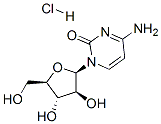| CytarabiniHydrochloridum |
|
| (CAS 69-74-9) |
 |
| Description: |
Cytarabine (AraC) is an antimetabolic agent and DNA synthesis inhibitor.
Target: DNA/RNA Synthesis
Cytarabine (AraC) is phosphorylated into a triphosphate form (Ara-CTP) involving deoxycytidine kinase (dCK), which competes with dCTP for incorporation into DNA, and then blocks DNA synthesis by inhibiting the function of DNA and RNA polymerases. Cytarabine displays a higher growth inhibitory activity towards wild-type CCRF-CEM cells compared to other acute myelogenous leukemia (AML) cells with IC50 of 16 nM [1]. Cytarabine apparently induces apoptosis of rat sympathetic neurons at 10 μM, of which 100 μM shows the highest toxicity and kills over 80% of the neurons by 84 hours, involving the release of mitochondrial cytochrome-c and the activation of caspase-3, and the toxicity can be attenuated by p53 knockdown and delayed by bax deletion [2].
Cytarabine (250 mg/kg) also causes placental growth retardation and increases placental trophoblastic cells apoptosis in the placental labyrinth zone of the pregnant Slc:Wistar rats [3]. Cytarabine is highly effective against acute leukaemias, which causes the characteristic G1/S blockage and synchronization, and increases the survival time for leukaemic Brown Norway rats in a weak dose-related fashion indicating that the use of higher dosages of Cytarabine does not contribute to its antileukaemic effectiveness in man [4].
|
| Product No. |
KT20872 |
| Product Name |
CytarabiniHydrochloridum |
| Synonyms |
|
| Formal Name |
|
| CAS Number |
69-74-9 |
| Molecular Formula |
C9H14ClN3O5 |
| Formula Weight |
279.68 |
| Formulation |
A crystalline solid |
| Purity |
98%min |
| Stability |
2 years |
| Storage |
-20°C |
| Shipping |
USD45 for Europe and USA. No shipping charge once amount reach USD500 |
| Quality Control |
HNMR,CNMR,LCMS,HPLC,IR,etc. |
| Price & Availability |
In Stock. Price Negotiated. |
|
| Related Products: |
5-Azacytidine
5-Azacitidine(5-AzaC) is a nucleoside analogue of cytidine that specifically inhibits DNA methylation by trapping DNA methyltransferases.
IC50 Value: Azacitidine inhibits the L1210 cells growth with IC50 and of 0.019 μg/mL.
Target: DNMT
in vitro: Azacitidine is widely used to demonstrate the correlation between loss of methylation in specifc gene regions and activation of the associated genes. After incorporation into DNA, Azacitidine inhibits DNA methyltransferase noncompetitively, causing a block in cytosine methylation in newly replicated DNA but not in resting, nondividing cells[1]. Azacitidine induces differentiation of Friend Erythroleukemia Cell C3H10T1/2 with myotube formation[2]. Azacitidine can be activated to the nucleoside triphosphate and incorporate into both DNA and RNA, leading to inhibition of DNA, RNA and protein synthesis in normal eukaryotic cells and in cancer cell lines, which could finally leads to cell death. Azacitidine also inhibits the incorporation of purine metabolites into macromolecules. Azacitidine inhibits the L1210 cells growth with IC50 and of 0.019 μg/mL[3] .
in vivo: Azacitidine inhibits polynucleotide synthesis in leukemic BDF1 mice[3] . Azacitidine (3 mg/kg, i.p.) increases the mean survival time in leukemic BDF1 mice inoculated with Ll210 ascites tumor cells. Azacitidine markedly suppresses all enzymes activity in the polyamine-biosynthetic pathway, including ornithine decarboxylase activity. putrescine-dependent S-adenosyl-L-methionine decarboxylase activity, and spermidine-dependent S-adenosyl-L-methionine decarboxylase activity. Azacitidine also inhibits the accumulations of polyamines in leukemic mice[4].
Clinical trail: A Phase III study to the Azacitidine on clinically significant adverse cardiovascular and cerebrovascular events in high-risk subjects undergoing coronary artery bypass graft (CABG) surgery has been completed
|
|


